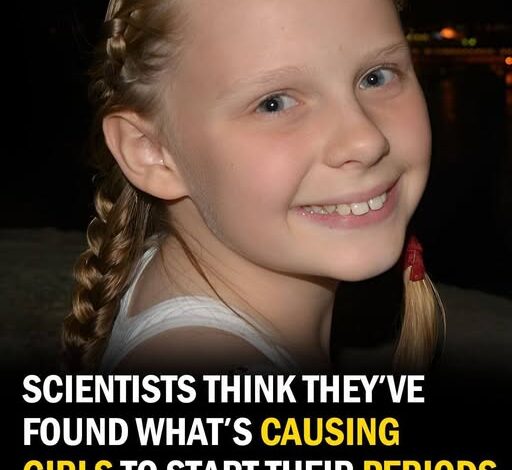
Scientists Finally Figure Out Whats Causing Girls to Get Periods at a Younger Age
Across the United States, scientists are sounding the alarm over a concerning biological shift: girls are beginning menstruation at increasingly younger ages. What was once considered rare—starting periods before the age of 11, or in some cases even before 9—has now become a growing trend. Researchers and public health experts are working to understand what’s driving this change and what it means for the long-term health and well-being of young girls.
Recent large-scale studies, involving over seventy-one thousand participants, confirm that the age of first menstruation—known as menarche—has been steadily declining for several decades. Even more striking is the fact that many girls are now experiencing a longer period of hormonal irregularity after their first period, suggesting deeper disruptions in the body’s natural development.
The data shows that this trend isn’t distributed evenly across the population. Early puberty is occurring most often among girls from racial minority groups and lower-income households. This uneven pattern has led experts to believe that social and environmental inequities—everything from stress and pollution to access to healthy food—are influencing the timing of puberty in ways that go far beyond genetics.
While there’s no single cause, one of the most widely recognized factors behind earlier menstruation is the rise in childhood obesity. Excess body fat increases the production of estrogen, the hormone that triggers puberty. When children have higher body mass index (BMI) levels, their hormonal balance can shift prematurely, setting off early physical development. Over the past few decades, as childhood obesity rates have soared across the country, the average age of menarche has continued to drop.
However, scientists stress that body weight alone doesn’t tell the whole story. The early onset of puberty appears to be linked to a complex network of influences, including psychological stress, diet, sleep patterns, and environmental toxins. Chronic stress, for instance, can affect the brain’s hypothalamic-pituitary-adrenal (HPA) axis—the system that regulates hormones tied to puberty and reproduction. In children exposed to trauma or high-stress environments, hormonal signals may activate earlier, pushing the body into puberty before it’s emotionally or physically ready.
Another major factor under scrutiny is exposure to endocrine-disrupting chemicals (EDCs). These substances are found in everyday products—plastic containers, cosmetics, cleaning agents, processed foods, and even the coatings of receipts. EDCs can mimic or block the actions of natural hormones, throwing the body’s endocrine system off balance. When children come into regular contact with these chemicals, particularly during vulnerable developmental stages, it can lead to earlier hormonal activation.
The consequences of early menstruation go far beyond the inconvenience of starting puberty young. Medical research has shown that girls who begin their periods earlier face higher lifetime risks for several serious conditions, including breast, ovarian, and endometrial cancers. Prolonged exposure to estrogen increases these risks, as well as the likelihood of heart disease and stroke later in life.
Reproductive health is another concern. Girls who experience early puberty are more likely to face hormonal disorders such as polycystic ovary syndrome (PCOS), infertility issues, and irregular menstrual cycles as adults. Psychologically, they often struggle with anxiety, depression, and distorted body image—pressures that are intensified when a young girl’s body develops ahead of her emotional maturity.
Socially, early puberty can isolate girls who are still mentally children but look physically older. They may attract unwanted attention or face bullying from peers who don’t understand their situation. Teachers and parents often underestimate the emotional toll this takes, and many girls navigate this confusing stage without proper guidance or support.
Experts stress that prevention must start early, and that education is crucial. Families can help by encouraging balanced nutrition, regular physical activity, and open discussions about body changes. Diets rich in whole foods and low in processed items can help regulate hormone levels, while regular exercise supports healthy body weight and stress management. Mindfulness activities, sports, and creative hobbies can reduce the chronic stress that contributes to hormonal imbalance.
Environmental awareness is also key. Parents can reduce exposure to harmful chemicals by limiting plastic use, avoiding heavily fragranced products, and choosing natural cleaning supplies whenever possible. Reading product labels for common EDCs—such as phthalates, parabens, and bisphenols—can make a significant difference.
Still, public health experts emphasize that personal choices, while helpful, can’t solve the problem alone. Systemic changes are needed to address the root causes of early puberty. That means stronger regulations on industrial and consumer chemicals, better access to fresh and affordable food, and expanded education about hormonal health for parents and children alike.
The trend also exposes broader social inequalities. Lower-income families often live in environments with greater exposure to pollutants, fewer healthy food options, and higher stress levels due to economic instability. These conditions combine to create a perfect storm for biological disruption. To make real progress, policymakers must recognize that early puberty is not just a medical concern but a public health and social justice issue.
Ongoing research aims to untangle how environmental and social conditions interact with biology. Understanding these connections will be vital in creating targeted interventions. For instance, studies are investigating how long-term exposure to microplastics or synthetic hormones in food packaging affects children’s endocrine systems. Other research is exploring whether chronic exposure to stress hormones in early life can permanently alter the body’s reproductive timeline.
While the problem is complex, experts are hopeful. Awareness of endocrine disruptors and the long-term effects of diet and stress is growing. Public pressure has already led to bans or restrictions on certain harmful chemicals in baby bottles, food packaging, and cosmetics. The next step is comprehensive legislation to reduce children’s exposure across all areas of life.
In the meantime, open communication and education remain the strongest tools parents have. Pediatricians encourage parents to talk to their daughters about puberty before it begins—ideally by age eight or nine. Honest conversations can help normalize the changes their bodies are going through and reduce feelings of fear or embarrassment.
The earlier onset of menstruation in girls is not just a biological phenomenon — it’s a reflection of the modern world we’ve built. From diet and stress to environmental pollution and economic inequality, the forces shaping our children’s development are intertwined with the systems that govern everyday life.
As one public health expert put it, “Early puberty isn’t just about hormones — it’s a mirror showing us how society treats children’s bodies.”
Ultimately, the goal isn’t to stop puberty from happening, but to ensure it happens when the body is ready — not when the environment forces it. Addressing this issue will take cooperation from families, educators, policymakers, and industries alike.
If the trend of earlier menstruation teaches us anything, it’s that children’s health doesn’t exist in isolation. It’s tied to every aspect of the world around them — and the responsibility to protect that world belongs to all of us.




